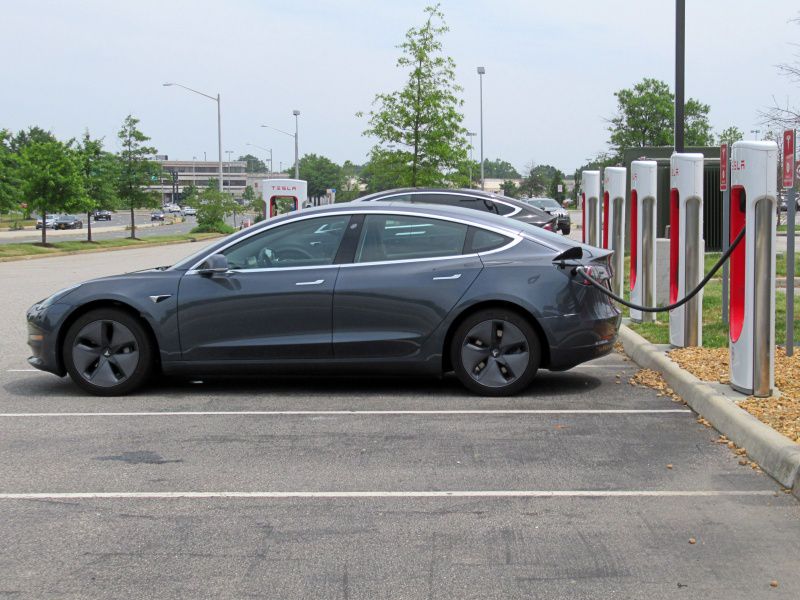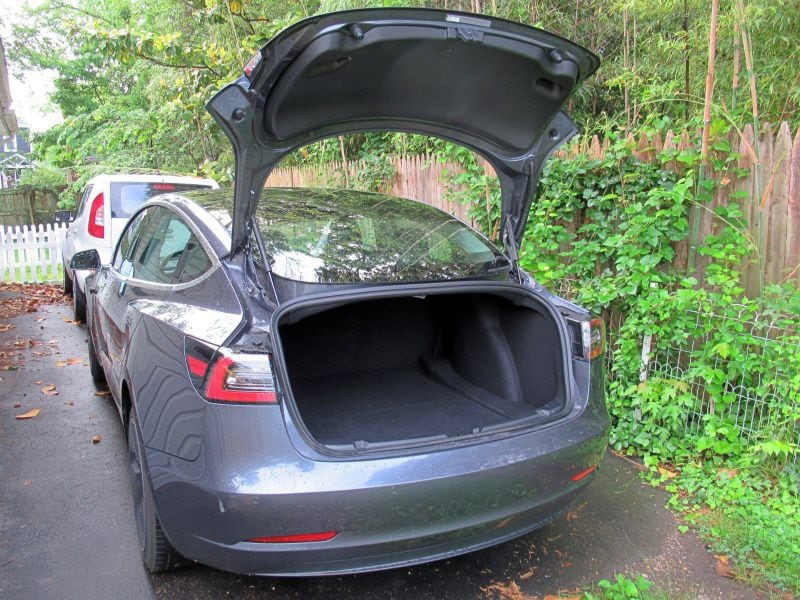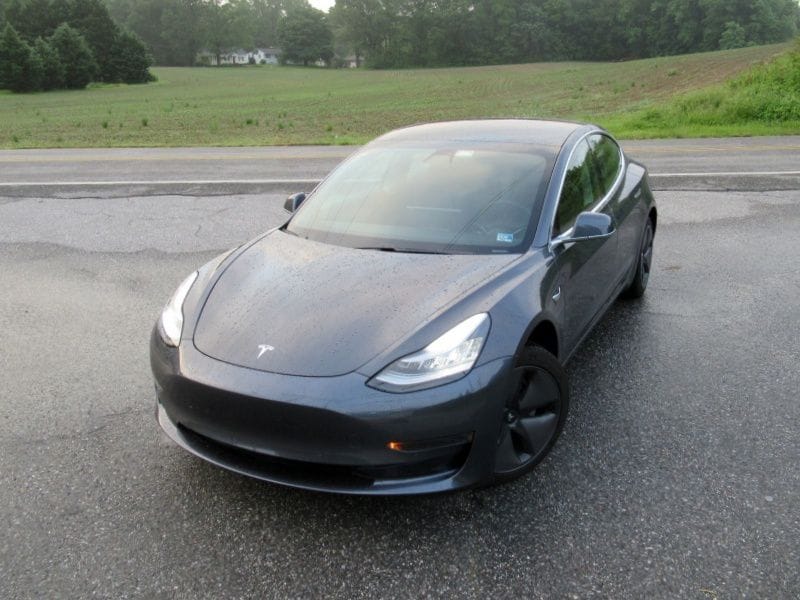Recent Articles
Popular Makes
Body Types
2020 Tesla Model 3 Road Test and Review

2020 Tesla Model 3 ・ Photo by Brady Holt
For years, an affordable Tesla was an unrealized promise. First, the company talked about its fantastic yet inexpensive electric car long before it was able to build one. Then it was finally in production, but only if you put down a deposit, settled into the end of a long waitlist, and paid extra for a fully loaded model.
But if you haven’t been paying attention, you might have missed that the promise has become reality. The 2020 Tesla Model 3 now starts at just $37,990 — and that’s for a well-equipped, sharp-driving, tech-laden, unconventional compact luxury sedan that you can buy right now. And thanks to Tesla’s relentless focus on marketing, technology, and the overall user experience, the Model 3 outsold every other electric car in the country last year... combined. And it outsold every other luxury car, too. Whether you want a fun-to-drive luxury sedan or to cut your carbon footprint, read on to see if Tesla makes the right car for you.
What It Costs
We won’t pretend that $37,990 is cheap. But that’s within a few dollars of the average selling price of a new car today. And unlike most luxury carmakers, Tesla doesn’t inflate the base price with lots of costly extras.
The Model 3’s standard equipment includes items that would cost you thousands extra on many luxury sedans: a huge infotainment screen with built-in navigation and 30 days of free internet, Tesla’s Autopilot suite of advanced crash-prevention technologies, rain-sensing windshield wipers, heated 12-way power-adjustable front seats, a power-adjustable steering column, real-wood cabin trim, and a panoramic glass roof. A few more features come bundled if you upgrade to the powertrain to the all-wheel-drive Long Range ($46,990) or Performance ($54,990): heated rear seats, LED foglights, and 12 months of free internet access. With each powertrain, you pay $1,000 to get any paint but white, $1,000 for a two-tone black-and-white interior, $1,500 for “sport” alloy wheels (standard on the Performance), and $7,000 for upgraded driver-assistance features. Most luxury cars can add more features — the Model 3 doesn’t offer ventilated seats or an opening sunroof — but Tesla provides a lot for the money.

Photo by Brady Holt
Range and Charging
The different Tesla powertrains prioritize either affordability, the longest range, or the quickest acceleration. The base Standard Range Plus model, like our test car, has an EPA-estimated 250 miles of range per charge and averages 141 mpg-equivalent (MPGe). Tesla estimates it will accelerate from 0 to 60 mph in a zippy 5.3 seconds. The Long Range provides 322 miles of charge at 121 MPGe and hits 60 mph in 4.4 seconds, while the Performance provides 299 miles of charge at 113 MPGe and reaches 60 mph in a blistering 3.2 seconds.
Depending on your model, charging from zero takes about eight to 10 hours on a standard 240-volt car charger, and you can plug in at any household outlet to get roughly eight miles of charge per hour — enough to top off overnight, if not enough to recover quickly from a road trip. You also wouldn’t expect to regularly run your battery all the way to zero, which would also reduce battery life. As a Tesla-exclusive perk, the company maintains its own “Supercharger” public charging stations that deliver quick bursts of electricity, providing a hundred miles of charge in a matter of minutes.

Photo by Brady Holt
Looks Modern
The Tesla Model 3 exterior has a clean, timeless look. It doesn’t have the cry out for attention like some flashy luxury sedans or the aggressively futuristic electrified models, but nor would you confuse it with an ordinary small car. The front end has no grille — there’s no engine that needs air cooling — and the gently curved, aerodynamic roof is classy and distinctive. The profile sweeps back toward the crisply tailored rear end.
Inside, the cabin is even more unconventional. The dashboard is adorned with a strip of wood, and that’s it except for the steering wheel and the 15-inch touchscreen. There are no buttons and knobs. Vents are concealed beyond the wood. You rely on the touchscreen, steering wheel controls, and a couple of stalks on the steering column. This stark “less is more” vibe helps set Tesla apart. We have some aesthetic nitpicks: a ragged edge on part of the wood trim (visible only with the driver door open), doors that closed with a clunky slam, and cheap plastic around the steering wheel controls. But as long as you embrace technology, we think you’ll like how the Model 3’s cabin looks.

Photo by Brady Holt
All-Encompassing Infotainment
We’re happy to defend the Model 3’s unusual interior aesthetic. We’re less thrilled with the ergonomic result. Relying on the touchscreen for basic driving functions is an unwelcome driving distraction. You need the touchscreen if you want to adjust your mirrors, windshield wipers, or headlights. You need to look at it for your vehicle’s speed. You need it to adjust the climate-control temperature or the audio volume.
As a piece of technology, the Model 3’s infotainment system is well-executed. It’s logical, attractive, and responsive. Its GPS satellite views are beautiful, and its predictive navigation inputs are more like a smartphone than the clunky system typical in cars. But you look at it longer than you would in a conventional automobile. It’s easier to use than you might expect but more distracting than a car should be. Note that some functions like live traffic information require an active internet connection after a trial period expires; you can either use your cellphone to create a Wi-Fi hotspot or you can pay Tesla a reasonable $10/month for internet. Android Auto and Apple CarPlay smartphone integration aren’t available, but the built-in navigation system is already derived from Google Maps.

Photo by Brady Holt
Decently Spacious
The Tesla Model 3 is significantly smaller than the flagship Model S, which results in a less expansive rear seat and cargo hold. We’ve read some harsh criticisms of the Model 3’s rear seat, calling it too low and lacking in legroom, but we found it better than many compact luxury sports sedans. The floor is also nearly entirely flat, unlike other rear-wheel-drive sedans, because there’s no engine in the front that needs to connect to the rear wheels. That makes the Model 3 unusually accommodating for a center-rear passenger for a car this size.
Although the Model 3 is shaped like the Model S, it has a conventional trunk instead of a more versatile liftback. That reduces trunk space in the back to 15 cubic feet, which is barely half what you get in the Model S, and you also don’t get a large open area when you fold down the Model 3’s rear seat. Both Teslas do feature a front trunk (or frunk) for a bit of extra storage space where a gasoline-powered car would have an engine.

Photo by Brady Holt
A True Sports Sedan
Many electric cars have focused on economical transportation. Tesla has stood out for its performance focus. With its balanced rear-wheel-drive architecture and the low center of gravity from its centrally mounted battery pack, the Model 3 is a sharp-handling sports sedan.
You don’t have to love electric cars to appreciate the Model 3’s direct, responsive steering — to say nothing of its extreme acceleration. Even the base model is quicker than most similarly priced sedans, while the Performance model rivals six-figure supercars in a straight line. And the well-bolstered front seats hold the driver snugly in place during fast cornering. As with many cars, you can adjust the throttle responsiveness and the steering effort for a more relaxed, easygoing experience. However, you can’t adjust the stiff suspension that’s on the harsh side when it hits a bump; the Model 3 slams more clumsily than the muffled “whump” many luxury sedans provide.

Photo by Brady Holt
Driverless Technology
Tesla is famous for its standard Autopilot technology and its optional “Full Self-Driving Capability” package. Tesla has made bold claims about its vehicles’ current and future ability to operate without driver intervention. But while the technology is indeed impressive, much of it is widely available across the auto industry.
Autopilot includes adaptive cruise control that can vary your speed based on the speed of a car in front of you, automatic emergency braking that can slam the brakes to avoid or mitigate an impact, and lane-keeping steering corrections that keep the vehicle in its lane. You’ll get all the same on every Toyota Corolla or Honda Civic, and countless other models. Tesla’s big infotainment screen has a unique display showing exactly what the car’s sensors are “seeing” — vehicles and other obstacles, lane markings, and traffic signals — but other cars see them, too. And even with “Full Self-Driving,” Tesla warns against actually taking your hands off the steering wheel even as the vehicle executes more complex maneuvers like lane changes and automatically following its own GPS directions. Other capabilities include self-parking (also available on a number of other cars) and driverless summoning (rare but not Tesla-exclusive).

Photo by Brady Holt
Alternatives to Consider
The Model 3 combines luxury style and performance, above-average range per charge, and comparatively affordable prices. That’s a unique combination in today’s electric-car market. But there are other options that might fit you well, too.
If you just want to cut gasoline and don’t need a high-tech or high-performance vehicle, the Nissan LEAF is a sensible, spacious, user-friendly, and affordable hatchback that goes 150 miles per charge in its base version and up to 226 miles per charge with its optional upgraded battery pack. And while Tesla already used up its allotment of federal tax incentives, Nissan buyers can still get a $7,500 tax rebate. Meanwhile, the Chevrolet Bolt and Hyundai Kona EV small front-wheel-drive crossovers both beat the base Model 3’s range for less money, and they’re sportier to drive than the Leaf, but they still lack Tesla’s high-end, cutting-edge feel. Another option for an electrified commuter car is a plug-in hybrid with 25 to 50 miles of all-electric range plus a gasoline engine for longer trips. Lastly, Tesla’s newly introduced Model Y — a crossover version of the Model 3 — provides more room and a higher seating position, though at a higher price.

Photo by Brady Holt
Unlike Other Cars
Even when evaluated like any other automobile, the Model 3 is impressive. It’s lightning-quick, it’s sharp-handling, it’s decently spacious, it’s well-equipped for the money by the standard of a luxury car, and it’s extremely efficient and affordable to operate.
But this isn’t a regular automobile. It presents itself convincingly as a car of the future, from the lack of dashboard buttons, to the lack of a key (you use a plastic card or your phone), to the elaborate Autopilot displays. And Tesla’s exclusive Supercharger network means you can get around more easily than any other electric car. The Model 3 is likely overkill for drivers who just want an efficient commuter car, and not everyone will appreciate its foibles such as the all-encompassing touchscreen and a less-than-opulent interior. But this is a standout automobile with no similarly desirable competitor in sight. Whether you want an electric car or any small luxury sedan, the 2020 Tesla Model 3 is worth your consideration.

Photo by Brady Holt